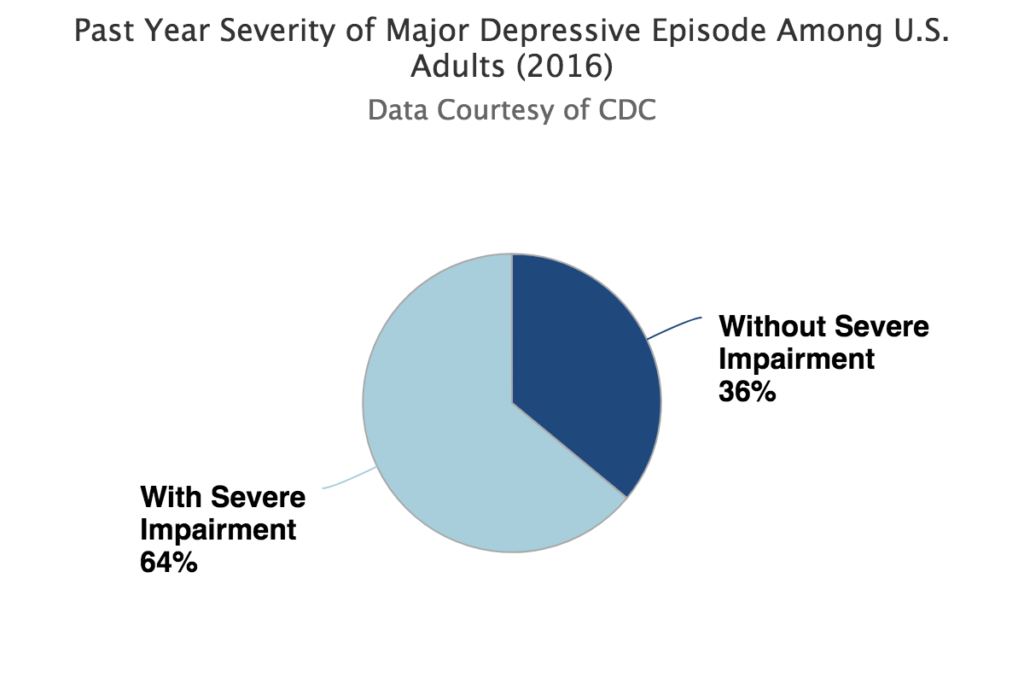Like any injury or illness, depression may range in severity and presentation. Symptoms of depression also vary from person to person with regard to physical, emotional, mental, spiritual, and relational impact.
Sadness, loneliness, hopelessness, and confusion are individual experiences that we can relate to and often find a “quick fix” for. But what about the times when all of those things seem to settle in at the same time?
 According to the World Health Organization, 300 million people around the world have depression. Approximately 16.2 million adults in the United States have experienced a major depressive episode in the past year with 10.3 million of those adults experiencing severe impairment as a result of the episode (as displayed in the graph below).
According to the World Health Organization, 300 million people around the world have depression. Approximately 16.2 million adults in the United States have experienced a major depressive episode in the past year with 10.3 million of those adults experiencing severe impairment as a result of the episode (as displayed in the graph below).
Although there are different classifications of depressive symptoms such as postpartum depression and seasonal affective disorder, this article references clinical depression: what to look for and when to find help.

When at its worst, depression can lead to suicide with nearly 800,000 deaths each year. The World Health Organization also reports that suicide is the second leading cause of death for 15-29-year-olds globally. Please pause for a moment and let these numbers sink in. It is staggering to consider the scale of depression’s effect on our world.
When faced with these statistics, it is not difficult to acknowledge the prevalence of depression. The numbers point to significance. However, the way we typically engage with this type of mental illness is often uninformed or straight-out avoidant. It is well known that depression is serious, yet it is rarely discussed seriously.
To emphasize this point, I will tell you about an interaction that I recently witnessed. Two people were standing in front of me in a line a few days ago discussing a recent literal culinary flop. They were fairly animated and speaking loudly, piquing the interest of those around them.
Here is a snapshot of their interaction:
Person 1: “So after all of that work, I was carrying the cake over to the table when the kids came running through the kitchen and bumped me. The cake when flying and landed all over the floor! And in an instant, the dog was cleaning it up.”
Person 2: “Wow. I can’t believe that. I would’ve been so depressed.”
Person 1: “I was! The whole night was ruined after that.”
Having this article in mind, the interaction and the word choice, in particular, stood out. Did dropping the cake actually cause this person to experience depression? Given the tongue-in-cheek nature of the phrasing, the storyteller likely did not experience depression after the cake casualty.
However, their interaction highlights a significant social norm with regard to the language of mental health in our society. We complacently throw around variations of the word “depression” when our dessert is ruined, when our favorite team loses the big game, or after our shoes get soaked from an unexpected downpour of rain. We may be angry, sad, or disappointed but those circumstances alone certainly are not the root of depression.
So, what is clinical depression? And how would you know if you were experiencing it? Then one step further, what you do about it? This article will outline the general criteria of depression, what it may be like to experience depression, and what to do next.
Symptoms of Depression
The following are common symptoms of depression as outlined by the DSM 5:
Depressed mood
 Feeling sad, empty, and perhaps hopeless. Friends and family may be noticing a change in demeanor. This shift is noted as lasting for at least two weeks.
Feeling sad, empty, and perhaps hopeless. Friends and family may be noticing a change in demeanor. This shift is noted as lasting for at least two weeks.
Lack of Interest
Significant diminished interest or pleasure in all, or almost all, activities most of the day, nearly every day.
Change in Appetite
Either a strong increase or decrease in appetite, noting weight loss or weight gain when not dieting or changing eating habits.
Change in Sleep
Unable to sleep or sleeping more than usual.
Physical Change
Restlessness or unintentional slowed motor skills.
Fatigue
Fatigue or lack of energy nearly every day.
Guilt
Feelings of worthlessness or excessive or inappropriate guilt nearly every day.
Concentration
Diminished ability to think or concentrate, or indecisiveness.
Thoughts of Death
Recurrent thoughts of death and/or suicide.
When thinking about depression is often easy to think about someone we know or an idea of “someone who’s depressed”. Applying these symptoms to ourselves requires an admission that things may not be perfect and that there are some challenges in life right now. Going through the list of symptoms, you may have thought “I experience that sometimes” or “I’ve definitely noticed that, but I’m not depressed”.
It may be helpful to know that depression presents differently in different people. There are a number of contributing factors such as age, sex, brain chemistry, life circumstances, and family history that impact how a person experiences depression. It is also important to note that symptoms are different in different people.
Someone may be experiencing all of the symptoms while another person may be experiencing one or two. It can be difficult to know what depression in your life looks like due to what we have perceived depression to be in others. We think about times that we have felt “down” or others who have depression and compare our current experiences against them.
Take a moment to consider this reflective story:
“A few summers back, I was spending time with good friends away from the city. The air was fresh, the sun was bright and warm, and I was grateful to be in good company. One afternoon, after a large meal at a nearby restaurant, someone suggested we go for a walk by the water. In a rare moment of agreement between all group members, we meandered along the shoreline catching up and laughing about a funny moment the day before and commenting on how lethargic we were feeling.
Gradually conversation slowed, and we began to spread out. A couple sat down on a large piece of driftwood, another person scouted for the perfect skipping rock, and I continued to stroll along the water. While taking in the rhythmic sound of the waves folding upon the shore and feeling the sand glide between my toes, I spotted what appeared to be a crab scampering across the ground in front of me.
Following the tracks carefully, I hoped to get a better look at the speedy creature. The tracks led to a small pile of shells. I scanned carefully for the crab, noticing the various colors, shapes, and shimmer of the shells. Wondering how all of the shells ended up in the pile, I quickly found myself lost in my thoughts.
 In what felt like just a few moments later, I looked up and noticed a greyness had set in. I felt slight uneasiness and looked around; A thick fog was all around me. I could not hear my friends or even the birds that were chirping just a minute ago. Without really thinking, I sat down.
In what felt like just a few moments later, I looked up and noticed a greyness had set in. I felt slight uneasiness and looked around; A thick fog was all around me. I could not hear my friends or even the birds that were chirping just a minute ago. Without really thinking, I sat down.
The shells and pebbles beneath me were cold. I suddenly was acutely aware of my low energy state after the large meal. I remember thinking about the possibility of danger but not really considering any safety concerns at the moment. As I sat on the cold shore, there did not seem to be much of a point in attempting to move around in the thick fog. I just continued to sit on the log.
I am not sure how long the fog surrounded me or how long I sat there, but at some point, I stood up and started to follow my footsteps back toward my friends. As I started to reorient myself to the water and the direction that I came from, the fog began to lift, and my surroundings became clearer.
At the beginning of my time on the coast, I was enjoying my friends and surroundings as I walked along the water, but when the fog set in, I questioned where it came from and how long it was going to last. All enjoyment and fun were absent. To add to the weight of the experience, I questioned where my friends were and the value of trying to escape it. I was physically tired and mentally disengaged from my surroundings.”
For a moment, put yourself in the story on the beach. Are you sitting on the driftwood watching your friends skip rocks? Are you in the fog? Are you looking for someone? Depression is certainly more serious than fog setting in on the coast but this metaphor speaks to the influence of the illness. As a person experiencing depression may often feel like a heavy fog that blankets you out of nowhere.
Although it creeps in gradually, the contrast in how you experience life in the depression versus how you experience life prior may make the change feel sudden and disorienting. In one moment, you feel like yourself, you are surrounded by people that you feel a connection with and are moving in a direction that feels good. You are focused and attentive to what is happening.
In the next moment, you are feeling alone, directionless, tired, and stuck. You may wonder “Does anyone really care about me? Why am I this way? How do I stop or escape this feeling? Is it even possible or worthwhile?” Depression can often feel isolating.
If you imagined yourself as one of the friends in the story, you may recognize that it can also be isolating, challenging, and confusing to connect with a loved one who is dealing with depression. If you are a friend or family member of someone who you believe may be depressed, you may not be in the thick of the fog or know exactly what they are going through, but you like see or feel the presence of the fog, and certainly its impact on the environment.
Practical Next Steps to Treat Symptoms of Depression
Set up an initial appointment with a therapist
 If you are wondering if you may be experiencing depression, schedule a meeting with a professional who has experience in identifying and treating symptoms of depression.
If you are wondering if you may be experiencing depression, schedule a meeting with a professional who has experience in identifying and treating symptoms of depression.
If you are a support person unsure of what to do, it may be worthwhile for you to set up an appointment as well. Reach out to a few therapists to meet and better understand their therapeutic approach.
Building a strong relationship with your therapist is key to effective treatment. If in the first few sessions, it does not feel like a good fit, talk with your therapist about possible referrals. Although depression is common, the way that it is impacting your life is unique.
Even if you are having the thought that “therapy won’t help”, I encourage you to at least set up an initial appointment. Take the courageous step of connecting with a professional. When working with depression, the earlier treatment begins, the more effective it is.
Talk to your doctor
Some medical conditions, medications, viruses, and thyroid disorders may cause the same symptoms of depression. Talking to your primary care doctor can rule out these possibilities by discussing your symptoms, completing a physical exam, and possibly administering blood work.
Exercise
Exercise has an impact on mental health. Dr. Michael Craig Miller, assistant professor of psychiatry at Harvard Medical School, is quoted in the Harvard Health Letter:
“For some people, it works as well as antidepressants, although exercise alone isn’t enough for someone with severe depression… In people who are depressed, neuroscientists have noticed that the hippocampus in the brain—the region that helps regulate mood—is smaller. Exercise supports nerve cell growth in the hippocampus, improving nerve cell connections, which helps relieve depression.”
Build support
Do you have people in your life that you connect with regularly? Have the people in your life noticed a change in you? Your partner, friends, and family may be seeing changes in you and they may offer support for you in seeking help and managing your symptoms. If you feel comfortable talking with them about what you are experiencing, open the conversation in order to build connection and support.
Perhaps you have felt the fog and said, “I just don’t feel like myself. The old me was engaged and productive. I know it sounds bad to say this, but I just don’t care about much anymore.” This may be an indication that you are experiencing depression.
Or it may indicate other challenges that you are experiencing in life. Either way, connecting with a therapist will offer insight into your circumstances and where you may go from here. You are not alone.
Graph: https://www.nimh.nih.gov/health/statistics/major-depression.shtml
Photos:
“Fog Ship”, Courtesy of Engin Akyurt, Pixabay.com; CC0 License; “Groynes Wave Breaks Seascape”, Courtesy of Tim Hill, Pixabay.com; CC0 License; “Fog Dawn Landscape”, Courtesy of Analogicus, Pixabay.com; CC0 License; “Wooden Pier”, Courtesy of SplitShire, Pixabay.com; CC0 License





